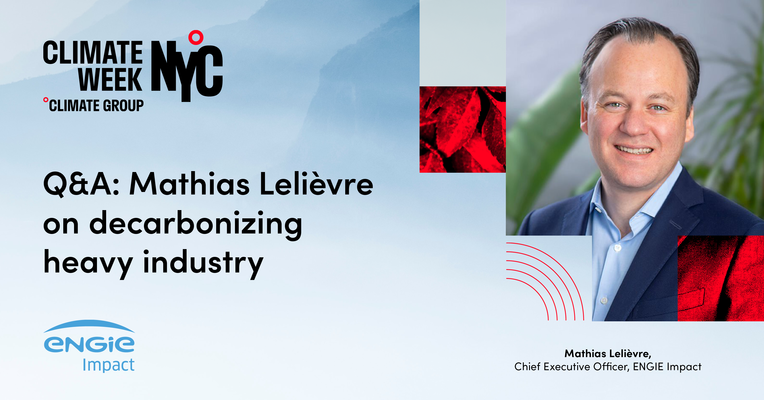Ahead of Climate Week NYC, we spoke with Mathias Lelievre, Chief Executive Officer, ENGIE Impact for a Q&A around heavy industry:
1. Industrial and manufacturing companies play a vital role for most other sectors given their role in the supply chain. Can you talk about the state of sustainability for manufacturers?
Manufacturers not only face unique decarbonization challenges, but they are positioned — and often expected through both competitive and consumer pressures — to be leaders in addressing Scope 1, Scope 2, and Scope 3 emissions.
Manufacturers might not be equipped to collect the necessary data across their portfolio in order to make data-driven decisions around resource use and carbon management, therefore making it challenging to prioritize efficient energy and resource use throughout the manufacturing process. On top of that, they’re constantly balancing the need to meet production and short-term profit goals while making longer-term investments that will pay off in the long run.
That said, while some manufacturers are doing this very well, many are not. The challenge is looking at decarbonization as an enterprise-wide transformation and not a series of one-off projects, which can be particularly difficult for a sector that faces challenges like rigid production processes and quality demands, tight profit margins, and large footprints that cover multiple, varying geographies.
Manufacturers don’t have the luxury of putting off Scope 3 emission reduction. Manufacturers that know this are taking steps to tackle Scope 3 emission reduction, but it takes a massive amount of expertise and capabilities to define a future state around your supply chain.
2. Industrials are known for having hard-to-abate emissions while facing intense pressure to decarbonize. How are organizations balancing these competing elements?
Emissions are high, but so are the goals. We do see manufacturers stepping up and setting ambitious targets to try to make an impact. Initial findings from our upcoming 2024 Net Zero Report showed 72% of manufacturing industry respondents said their organization has made public commitments around Scope 1, Scope 2 or Scope 3. Among other industries surveyed, less than two-thirds (64%) had made similar public commitments.
To have a chance of reaching these goals, manufacturers need to continue to innovate, be open to new technologies and identify the financing solutions that will make transformation possible. But they also need to be keenly aware of the financing options that are available to them to make those transformations possible. One such opportunity comes from the DOE Office of Clean Energy Demonstrations (OCED), who in March 2023 issued a Funding Opportunity Announcement (FOA) for approximately $6 billion in grant money to accelerate decarbonization in energy-intensive industries through transformative projects that are first-of-a-kind or early-stage commercial scale.
3. What are the strategies and processes industrials are applying to achieve effective strategy implementation?
They must remember that decarbonization is a foundational, holistic transformation, not just a corporate project. Corporate decarbonization requires a cultural shift that leads to foundational changes around how a company functions — if not, it will be much more difficult to align internal stakeholders on how to transition from strategy to implementation.
To highlight one challenge for manufacturers: many have multiple plants across global regions, having to navigate the varied regulatory requirements. Foundationally, your strategy needs to ensure it gives regions access to the best talent, the right approval structure and the appropriate knowledge base for each market and optimal technology solution. Imagine trying to procure renewable energy with one set of rigid guidelines and policies based on the reality of one region. That’s not a transformational approach that will allow local areas to capitalize on valuable opportunities when they arise.
If you’re not foundationally transforming how each region takes action, it will make implementation inefficient and likely chaotic.
4.Can you share an example of a client who has seen success implementing a large sustainability initiative?
We have a client serving the healthcare industry with technology solutions providing a wide range of services — from imaging and ultrasounds, to patient monitoring, to life-saving care like ventilators — with an ESG governance structure focusing on achieving set ambitions of at least a 50% reduction of Scope 1 and 2 emissions by 2030 against a 2019 baseline.
Because this is such a large, wide-ranging company, it was important for us to come in and help drive that transformation from within — getting everyone informed and involved. We led the implementation of a collaborative auditing and training program to identify supply, demand, renewable and clean energy projects, following four main principles:
- Value: Produce high ROI for both the training provided and via the potential energy savings identified
- Engagement: Collaborative experience resulting in buy-in across stakeholders
- Scale: Workshops are typically conducted with 10 sites at a time to allow for efficiencies of scale and replicability across an entire portfolio
- Speed: An efficient process with minimal demands on participants
We helped establish some site-specific benchmarking with actionable, clear pathways toward reduction goals — including prioritization of project opportunities both within a single site and across sites to support implementation sequencing. The workshops identified 9% potential annual cost reduction ($2.6 million per year), 8% potential demand reduction (30 GWh per year), 26% potential carbon reduction (28,600 MT per year) and more.
Overall, the client employees were empowered and equipped to lead and manage the plan, creating the lasting, long-term change necessary for them to reach their carbon commitments and business objectives.
